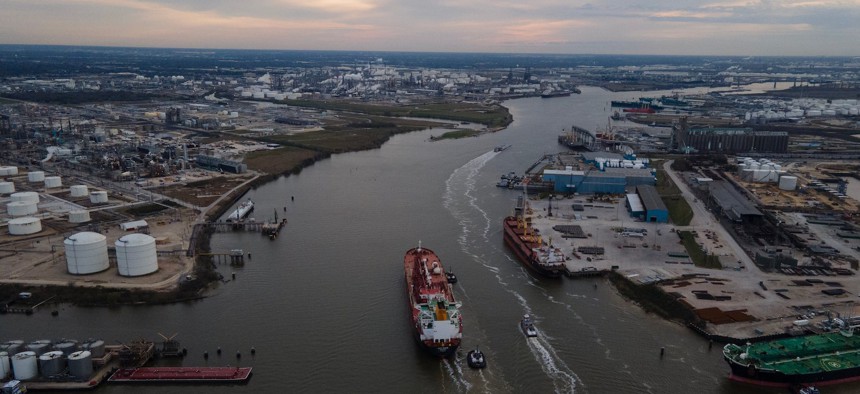
The Houston Ship Channel in February. A lawsuit filed by a group of environmental groups says the Environmental Protection Agency has failed to update its standards that control how much pollution industry can discharge into waterways. Mark Felix for The Texas Tribune
Environmental Groups Sue EPA Over Water Pollution Standards
A coalition of environmental groups claims the EPA has failed for decades to update limits on the discharge of some dangerous chemicals into waterways. Most of the worst polluters are in Texas.
"Environmental groups sue EPA over water pollution standards" was first published by The Texas Tribune, a nonprofit, nonpartisan media organization that informs Texans — and engages with them — about public policy, politics, government and statewide issues.
More than a dozen environmental groups are suing the U.S. Environmental Protection Agency for not revising its water pollution-control standards, which regulate the amount of harmful chemicals that can be dumped into rivers, lakes and streams. The groups claim the current standards haven’t been updated in decades, which violates the Clean Water Act.
Oil refineries, chemical and plastic plants, and other industrial facilities “dump billions of gallons of wastewater that contain nitrogen that fuels algae blooms and dead zones and toxins that are harmful to both humans and aquatic life like benzene and selenium,” said Jen Duggan, deputy director for the Environmental Integrity Project, one of the groups that’s suing the agency.
The lawsuit, which asks the federal government to direct the EPA to review its decision to not revise pollution limits earlier this year, was filed Tuesday in the U.S. Court of Appeals for the 9th Circuit in San Francisco.
Pollution standards for these industries were last updated 30, sometimes nearly 40 years ago, according to a letter sent by the organizations to EPA Administrator Michael Regan.
The EPA declined to comment on the lawsuit.
Under the Clean Water Act — the 1972 law designed to reduce pollution in America’s waterways — at least once every five years the EPA is required to evaluate and revise pollution limits for different types of industries based on the “best available technology economically achievable … which will result in reasonable further progress toward the national goal of eliminating the discharge of all pollutants.”
The lawsuit aims to force industrial plants to install more modern controls to reduce the volume and toxicity of the pollution being discharged into waterways.
New technologies that can reduce pollution include denitrification technology, which removes nitrogen from wastewater. Duggan said it’s already required for municipal sewage treatment plants that discharge into the Chesapeake Bay on the East Coast. She said the technology should be required at Texas refineries and other large producers of nitrogen pollution, which in many cases are operating under rules she called “ancient.”
“It’s really time for the EPA to do its job and require these plants to install modern wastewater-treatment controls and bring them into the 21st century,” she said.
A recent report by the Environmental Integrity Project examined the records of 81 refineries across the U.S. and found that an estimated 60,000 pounds of selenium were discharged into waterways in 2021, along with 10,000 pounds of nickel; close to 16 million pounds of nitrogen; and 1.6 billion pounds of chlorides, sulfates, and other dissolved solids. According to the EIP report, seven Texas companies landed on the top 10 biggest polluters for dissolved solids dumped into waterways in 2021.
Environmental advocates say the lack of strong regulations harms low-income communities and communities of color, which bear a disproportionate burden of industrial pollution.
The EIP report listed the most frequent violators, including the Phillips 66 Sweeny Refinery, south of Houston, which exceeded its permitted pollution limits 44 times from 2019-21; 42 violations were for discharging unpermitted cyanide pollution into the Brazos River, the report says. The company was penalized $30,000 for the violations, according to EPA records obtained by EIP.
Phillips 66 declined to comment.
Among the groups suing the EPA is the San Antonio Bay Estuarine Waterkeeper, an environmental advocacy organization headed by Diane Wilson, a fourth-generation retired shrimper and longtime environmental activist who reached a $50 million settlement with Formosa Plastics Corp. in 2019 after she sued the company for discharging plastic waste into Lavaca Bay and nearby waterways.
The 75-year-old Calhoun County resident, whose family has lived on the Texas Gulf Coast for more than a century and who battled Formosa for decades, said pollution limits are crucial.
“When you walk on the beaches, you can literally see microplastics in the water rolling in. When you have a boat tied up at the docks, you get a line of plastic around the hole of the boat. It blows your mind,” Wilson said.
We can’t wait to welcome you Sept. 21-23 to the 2023 Texas Tribune Festival, our multiday celebration of big, bold ideas about politics, public policy and the day’s news — all taking place just steps away from the Texas Capitol. When tickets go on sale in May, Tribune members will save big. Donate to join or renew today.
This article originally appeared in The Texas Tribune at https://www.texastribune.org/2023/04/11/epa-water-pollution-lawsuit/.
The Texas Tribune is a member-supported, nonpartisan newsroom informing and engaging Texans on state politics and policy. Learn more at texastribune.org.






